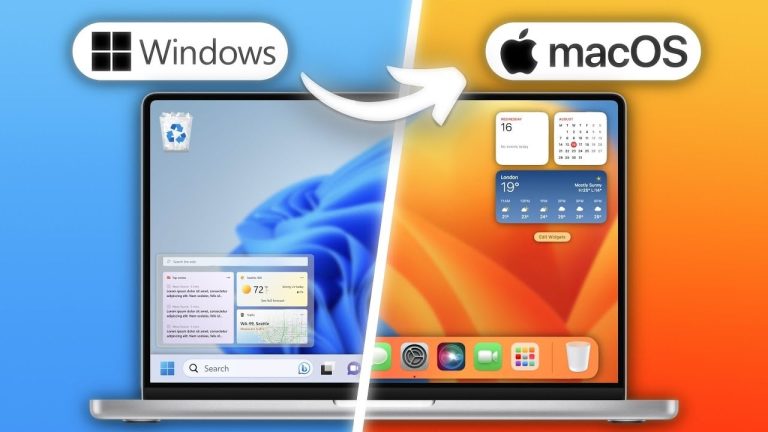If you are in the process of switching from Windows to a Mac, this guide is designed to provide you with a range of tips to help you switch between the two platforms. If the thought of transitioning from Windows to Mac seems daunting, rest assured that it can be a smooth and intuitive process. The secret lies in acquainting yourself with a handful of crucial differences and practical tips. This knowledge not only eases the switch but also enriches your computing experience manifold.
To guide you on this journey, we will explore the fundamental aspects of adapting to the Mac environment. Our goal is to ensure that you seamlessly integrate into the world of macOS, finding comfort and familiarity as you navigate your new device. Embracing these nuances, you will soon discover the joys and efficiencies of Mac, making it feel like a natural extension of your digital life. Let’s embark on this insightful journey, transforming the way you interact with your Mac, and making every moment spent with it feel like coming home.
Embracing the Right-Click
Contrary to popular belief, Macs fully support right-click functionalities. If you’re using the Magic Mouse, this feature might be disabled by default. Fear not, as a quick visit to the System Settings can activate this essential function, keeping the familiarity of Windows at your fingertips.
Dock: Your Shortcut to Efficiency
The Dock on a Mac is akin to the taskbar on Windows, offering swift access to your frequently used applications. Its highly customizable nature allows you to tailor it to your preferences, adding or removing apps as you see fit, thus creating a personalized user experience.
Notification Center & Widgets
Staying informed and organized is effortless with macOS’s Notification Center. Accessible with a simple two-finger swipe or a click on the time and date, it houses all your notifications and widgets in one convenient location. This feature ensures that you are always just a gesture away from your important updates.
Control Center: Quick Access Redefined
macOS brings the ease of quick settings adjustments to your fingertips. The Control Center, a compact yet comprehensive hub, offers immediate access to essential settings like sound, brightness, Wi-Fi, and Bluetooth. With one-click access, toggling these settings becomes a breeze.
Spotlight Search: Your Powerful Assistant
Searching on a Mac goes beyond the ordinary with Spotlight Search. This potent tool is not just about finding apps and files; it’s about efficiency. Whether it’s performing currency conversions, calculations, or searching text within files, Spotlight Search is your go-to for quick, in-depth searches.
Finder: Navigating Your Files with Ease
Finder plays the role of File Explorer on Mac, offering a clear and customizable pathway to your files and folders. Enhancing its functionality, options like the path bar and a customizable sidebar are at your disposal, ensuring quick access to your most important data.
Menu Bar and App Menus
Adaptability is the hallmark of the Mac’s menu bar. It smartly alters its functions based on the active application, placing all the necessary app-specific settings just a click away, typically under the app’s name in the menu.
Efficient App and Window Switching
Navigating between applications and windows is streamlined on a Mac. Using Command + Tab for app switching and Command + Tilde for toggling between windows of the same app, enhances multitasking efficiency. Additionally, features like Mission Control and Stage Manager offer advanced window management capabilities.
Window Management
While Macs don’t offer native window snapping, this feature can be replicated with third-party applications like Magnet, Rectangle, or BetterSnapTool, bringing the familiarity of Windows into the Mac ecosystem.
Closing Apps Effectively
A common misconception among new Mac users is that clicking the red circle completely closes an application. This action merely closes the window. To fully exit an app, using Command + Q or selecting Quit from the app’s menu is the way to go.
Force Quitting Unresponsive Apps
Similar to Windows’ Task Manager, the Force Quit option in the Mac’s Apple menu is a handy tool for closing unresponsive applications, ensuring that your system remains responsive and efficient.
Customizing Scroll Bars
macOS offers a sleek aesthetic with its default setting of showing scroll bars only during scrolling. However, for those who prefer a constant visual cue, the settings allow for the scroll bars to be visible at all times.
Summary
By highlighting these distinct features and differences, this guide endeavors to not only simplify your journey from Windows to Mac but also to elevate it. It’s about transforming the way you engage with technology. This isn’t merely a change of devices; it’s a significant enhancement of your entire computing experience. By delving into the unique aspects and functionalities of the Mac environment, we aim to provide you with a comprehensive understanding that goes beyond basic usage.
We want to ensure that your transition is not just smooth, but also enriching and enlightening, opening new avenues of productivity and ease. This guide is crafted to turn your switch into a journey of discovery, where you’re not just learning a new system, but also uncovering the potential to revolutionize how you work, create, and interact with your digital world.
Source & Image Credit: MacVince
Filed Under: Apple, Guides, Laptops
Latest timeswonderful Deals
Disclosure: Some of our articles include affiliate links. If you buy something through one of these links, timeswonderful may earn an affiliate commission. Learn about our Disclosure Policy.

